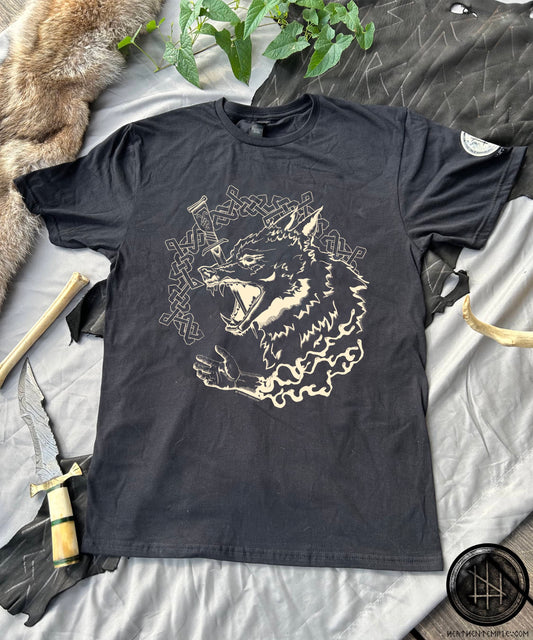The Enigmatic Fate of Fenrir: A Mythological Saga Unveiled
In the vast tapestry of Norse mythology, the figure of Fenrir, the monstrous wolf, stands out as a symbol of chaos and foreboding. Fenrir, son of the god Loki, is shrouded in mystery, with a fate that has captured the imaginations of many for centuries. This enigmatic creature is entangled in a web of prophecies and destiny, leading to a fate both tragic and significant in the grand scheme of Norse mythology. In this blog post, we will explore the story of Fenrir and the various interpretations of his fate.
The Birth of Fenrir
Fenrir's origins are rooted in the turbulent family dynamics of the Norse gods. Loki, a trickster deity, had a penchant for sowing chaos and discord among the gods, and this led to the birth of several ill-omened beings. Among them was Fenrir, a monstrous wolf of unimaginable size and strength. His birth was a dire harbinger of things to come.
Fenrir's growth was astonishing, and it became increasingly clear that he posed a significant threat to the gods. They realized that they needed to contain him before he became uncontrollable, which set the stage for the most well-known chapter in Fenrir's story.
The Binding of Fenrir
To prevent Fenrir from unleashing his destructive potential, the gods decided to bind him. They commissioned the finest craftsman in the cosmos, the dwarf brothers Brokkr and Sindri, to forge the unbreakable chain that would restrain the monstrous wolf. This chain, known as Gleipnir, was not just any ordinary chain; it was made from unusual materials, including the sound of a cat's footsteps, the beard of a woman, the roots of a mountain, and the breath of a fish. It was a chain that defied nature itself.
With cunning deception, the gods lured Fenrir into being bound by Gleipnir. Despite his formidable strength, the wolf was unable to break free, and he remained trapped until the events leading to Ragnarök, the apocalyptic battle that signaled the end of the Norse cosmos.
Fenrir's Role in Ragnarök
The prophecy surrounding Fenrir is inextricably linked to the cataclysmic events of Ragnarök. According to the prophecies of the Norse seeresses, during this final battle, Fenrir will finally break free from Gleipnir and unleash his fury upon the world. He will be one of the key players in the climactic showdown between the forces of chaos and destruction, and the gods and their allies.
Fenrir's arrival at Ragnarök signifies the end of the world as we know it. He is destined to devour Odin, the Allfather and chief of the gods, during the battle, a grim fate that mirrors the wolf's ominous reputation. The gods and their enemies will clash in a devastating confrontation, and the world will be consumed by fire and chaos.
The Symbolism of Fenrir's Fate
Fenrir's fate in Norse mythology holds significant symbolic value. His imprisonment and subsequent release in the context of Ragnarök are seen as a representation of the uncontainable forces of chaos that persistently threaten order and stability. Fenrir embodies the idea that even the gods, with their power and wisdom, are not invulnerable, and that the forces of destruction are always lurking on the fringes of existence.
Fenrir's role in devouring Odin, the father of the gods, also carries a potent message. It highlights the inevitability of mortality and the cyclical nature of existence. The death and rebirth of the cosmos, as depicted in the Ragnarök myth, symbolize the eternal ebb and flow of life, death, and renewal.
Alternative Interpretations
While the most well-known fate of Fenrir is his involvement in Ragnarök, there are alternative interpretations of his story. Some versions suggest that the gods were unjust in imprisoning him and that Fenrir represents the tragic victim of their fear and paranoia. In these interpretations, his escape and vengeance on the gods are seen as a form of divine retribution.
Additionally, some modern retellings of Norse mythology have sought to reframe Fenrir's character, portraying him as a misunderstood or even sympathetic figure. These interpretations emphasize his tragic isolation and estrangement from the divine world, casting him as a tragic anti-hero rather than a malevolent force of destruction.
Conclusion
The fate of Fenrir is a captivating and multi-faceted aspect of Norse mythology that has inspired countless interpretations and retellings over the centuries. Whether viewed as a harbinger of doom, a symbol of chaos, or a tragic figure, Fenrir's story continues to captivate our imaginations and remind us of the enduring power of myth and legend. His role in Ragnarök, the ultimate battle of Norse mythology, continues to be a testament to the eternal struggle between order and chaos in the grand tapestry of the cosmos.
Heathen Collection
The Fate of Fenrir Tshirt
Regular price
From $28.00 USD
Regular price
Sale price
From $28.00 USD
Unit price
per

Share your passion for Heathenism everywhere you go and join the Horde today!

